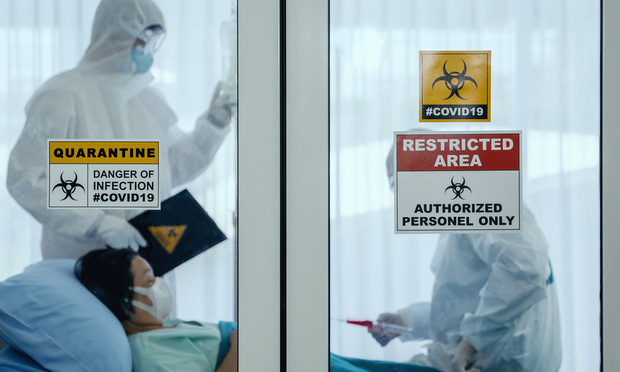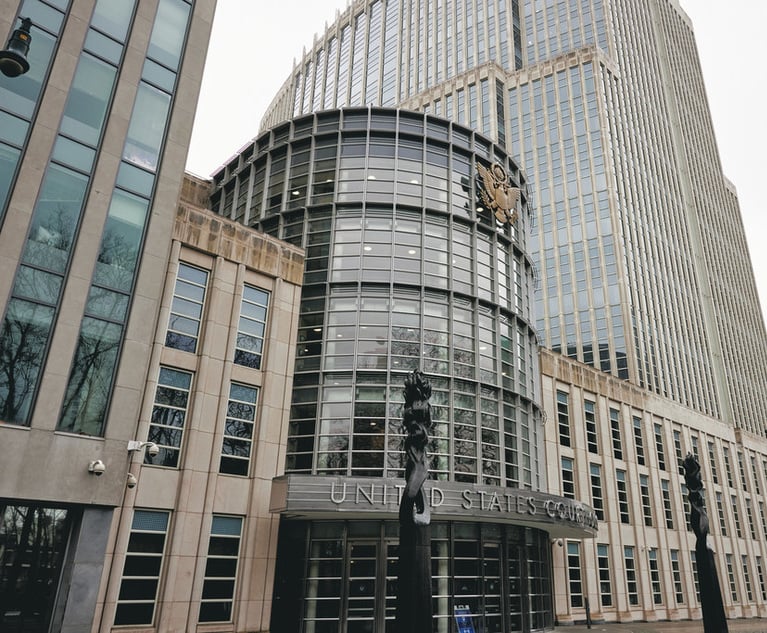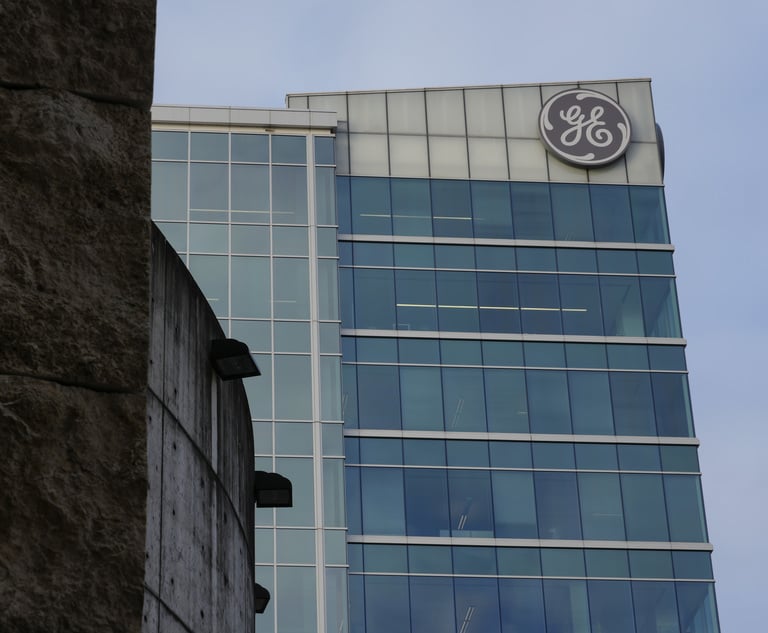Availability of Insurance Coverage for Immediate Coronavirus Losses
This article focuses on coverage for the immediate losses caused by coronavirus, including loss of revenue to businesses suddenly devoid of customers, businesses dealing with disrupted supply chains, and businesses forced to shutter either by concern for public health or by explicit government order.
March 25, 2020 at 11:45 AM
8 minute read
 Two medical staff wearing protective suits treating a woman infected with coronavirus (Covid-19) inside an isolation ward at a hospital. Photo: Mongkolchon Akesin/Shutterstock.com
Two medical staff wearing protective suits treating a woman infected with coronavirus (Covid-19) inside an isolation ward at a hospital. Photo: Mongkolchon Akesin/Shutterstock.com
The coronavirus pandemic affects almost every aspect of life, not just in New York, but across the United States and the globe. In addition to sickness and loss of life, the pandemic has had an immense impact on businesses around the globe, causing significant losses that are likely to continue for the foreseeable future.
The effect on business has been seen in the drastic actions taken by the New York City and state governments. On March 16, 2020, New York City Mayor Bill de Blasio issued Emergency Executive Order No. 100, which ordered, among other things, closure of all establishments serving food and drink (except for take-out and delivery) and closed all entertainment venues. New York Governor Andrew Cuomo signed the New York State on "PAUSE" executive order closing all non-essential businesses across New York State effective 8 p.m. on Sunday, March 22, 2020.
While policyholders may not have purchased insurance that specifically covers them in the event of a viral "pandemic", there are still avenues for those policyholders to seek insurance coverage for their losses, supported by case law from New York and around the country. This article focuses on coverage for the immediate losses caused by coronavirus, including loss of revenue to businesses suddenly devoid of customers, businesses dealing with disrupted supply chains, and businesses forced to shutter either by concern for public health or by explicit government order.
Business Interruption
Most first-party property insurance policies contain business interruption or time element coverage, which covers a policyholder's loss of business. Typically, these types of coverage are found under policies that insure physical loss or damage to its property. There have been numerous cases in which the physical loss or damage standard has been evaluated in the context of non-structural damage that renders a structure uninhabitable, such as exposure to odors or dangerous microscopic substances.
There is a nationwide consensus of authority providing that as long as a condition makes a property uninhabitable or deprives the policyholder of use of the property, that condition will constitute physical loss or damage.
A leading case applying New York law to this issue is Port Authority of New York & New Jersey v. Affiliated FM Insurance Co., 311 F.3d 226 (3d Cir. 2002). The Third Circuit stated: "[w]hen the presence of large quantities of asbestos in the air of a building is such as to make the structure uninhabitable and unusable, then there has been a distinct loss to its owner." Id. at 236. As part of this ruling, the court cited cases finding that when a condition made the use of a property unsafe, that would constitute direct physical loss or damage. Id. at 235. For further exploration of cases discussing this requirement, see TRAVCO v. Ward, 715 F. Supp. 2d 699 (E.D. Va. 2010) and Mellin v. N. Sec. Ins. Co., 115 A.3d 799 (N.H. 2015).
Moreover, Port Authority and other cases stand for the proposition, particularly applicable with regard to coronavirus, that a condition that causes an "imminent threat" of loss of utility to a property can also constitute direct physical loss or damage for purposes of business interruption coverage. See Port Auth., 311 F.3d at 226; see also, e.g., Murray v. State Farm Fire & Cas. Co., 509 S.E.2d 1, 17 (W. Va. 1998) (finding direct physical loss could include the imminent threat of rocks falling on a house that had not yet sustained any actual damage).
There can be no debate that the presence of coronavirus can make a business uninhabitable, unusable, or unsafe. For example, New York City Emergency Executive Order No. 100 states "the reduction of … meetings or other gatherings is necessary to combat the spread of the disease" and also that "the virus is physically is causing property loss and damage." Any person walking into a business can pose an imminent threat of spreading coronavirus. In this manner, and since policies typically require the insured to mitigate any ongoing losses, business interruption coverage could be available for businesses that closed their doors out of an abundance of caution to public health in the early stages of the outbreak in the United States.
Contingent Business Interruption
Another avenue for coverage for coronavirus losses is contingent business interruption or contingent time element coverage. Contingent business interruption coverage provides coverage for lost business sustained by the policyholder due to direct physical damage sustained by a supplier or customer.
As stated above, the presence of coronavirus at any location should satisfy the requirement of physical loss of or damage to property. While some policies have specific lists of contingent business interruption locations, for those that do not, contingent business interruption coverage has been broadly interpreted by courts. See, e.g., Park Electrochemical v. Cont'l Cas. Co., 2011 WL 703945 (E.D.N.Y. Feb, 18, 2011) (finding policy ambiguous as to whether a policyholder's subsidiaries could qualify as suppliers for contingent business interruption coverage); Archer-Daniels Midland Co. v. Phoenix Assurance Co., 936 F. Supp. 534, 540-44 (S.D. Ill. 1996) (finding that contingent business interruption coverage from Mississippi River flooding included the Army Corps of Engineers and all Midwestern farmers as suppliers despite the lack of direct relationship between the policyholder and those entities).
Virtually every business is suffering some kind of contingent business interruption due to coronavirus. Policyholders should document these added costs or lost revenues and make contingent business interruption claims.
Civil Ordinance and Ingress/Egress
Another avenue for coverage is coverage extensions in many property insurance policies for property that is inaccessible due to law or civil ordinance, or because the manner of ingress and egress to the property is inaccessible. This coverage is typically very straightforward. See, e.g., Fountain Powerboat Indus. v. Reliance Ins. Co., 119 F. Supp. 2d 552, 556-57 (E.D.N.C. 2000) ([T]he meaning of the [ingress/egress] clause is exceedingly clear.").
As mentioned above, to stem the tide of the coronavirus outbreak, city and state governments in New York and elsewhere have issued orders forcing many businesses to close and those that remain open to work at a reduced capacity. Law and civil ordinance coverage in a property policy could provide coverage for losses as a result of these actions. Moreover, the orders also call for people to remain at home as much as possible. In that manner, law or civil ordinance has deprived even businesses that remain open of customers at their usual frequency.
Exclusions
While there are several avenues to coverage for losses policyholders are already experiencing, the unfortunate reality is that many policyholders may face attempts by insurers to bar those avenues by virtue of exclusions in policies.
One exclusion is found in Insurance Services Office (ISO) form CP 01 40 07 06 entitled "Exclusion for Loss Due to Virus or Bacteria." ISO is a centralized service that drafts insurance policy language and circulates it to state regulatory agencies so that upon approval it can be used by insurers. The exclusion provides, in relevant part, that the insurer "will not pay for loss or damage caused by or resulting from any virus, bacterium or other microorganism that induces or is capable of inducing physical distress, illness or disease."
While in a vacuum this exclusion appears to encompass loss caused by coronavirus, it is critical for policyholders to analyze their entire policy to see if there are other provisions that could limit the applicability of this exclusion. Moreover, if insurers attempt to assert exclusions that are worded differently than this ISO exclusion, New York policyholders can argue that if insurers wanted to exclude coverage for disease-causing virus they should have done so more clearly.
Courts have been willing to afford very narrow interpretation to similar exclusions in the past. See, e.g., Old Town Canoe Co. v. Cont'l Cas. Co., 2005 WL 2674902, at *1-4 (D. Me. Oct. 20, 2005) (interpreting exclusion for loss caused by extremes of temperature (which also included bacteria or virus) to only apply to extremes of external temperature, not internal temperature).
An example of this narrow interpretation in New York law that will be relevant to coronavirus claims is New York courts' interpretation of pollution exclusions. New York courts have consistently recognized that while those exclusions may be broadly worded, they are intended to deal with broadly dispersed environmental pollutants, not other claims involving conditions that could arguably fit within the wording of the exclusions. See Belt Painting v. TIG Ins. Co., 100 N.Y.2d 377, 383-88 (2003). Any attempt by insurers to argue coverage for coronavirus losses is excluded under broad and general pollution exclusions would likely fail under New York law.
Conclusion
New York and the rest of the country and the world face significant challenges in the face of the coronavirus pandemic. Policyholders should proactively pursue insurance coverage to compensate them as fully as possible for the losses they have already incurred and will continue to incur.
Robin L. Cohen is a principal at McKool Smith and head of the firm's insurance recovery practice. Marc T. Ladd is a principal and Alexander M. Sugzda is an associate at the firm.
This content has been archived. It is available through our partners, LexisNexis® and Bloomberg Law.
To view this content, please continue to their sites.
Not a Lexis Subscriber?
Subscribe Now
Not a Bloomberg Law Subscriber?
Subscribe Now
NOT FOR REPRINT
© 2025 ALM Global, LLC, All Rights Reserved. Request academic re-use from www.copyright.com. All other uses, submit a request to [email protected]. For more information visit Asset & Logo Licensing.
You Might Like
View All
Insurance Company Sues Over 180 Health Care Providers for Fraud Under RICO
3 minute read
New York Court of Appeals Tightens Pleading Standards Against Insurance Policyholder
7 minute read
Amid Growing Litigation Volume, Don't Expect UnitedHealthcare to Change Its Stripes After CEO's Killing
6 minute read
GE Agrees to $362.5M Deal to End Shareholder Claims Over Power, Insurance Risks
2 minute readTrending Stories
- 1Decision of the Day: Judge Dismisses Defamation Suit by New York Philharmonic Oboist Accused of Sexual Misconduct
- 2California Court Denies Apple's Motion to Strike Allegations in Gender Bias Class Action
- 3US DOJ Threatens to Prosecute Local Officials Who Don't Aid Immigration Enforcement
- 4Kirkland Is Entering a New Market. Will Its Rates Get a Warm Welcome?
- 5African Law Firm Investigated Over ‘AI-Generated’ Case References
Who Got The Work
J. Brugh Lower of Gibbons has entered an appearance for industrial equipment supplier Devco Corporation in a pending trademark infringement lawsuit. The suit, accusing the defendant of selling knock-off Graco products, was filed Dec. 18 in New Jersey District Court by Rivkin Radler on behalf of Graco Inc. and Graco Minnesota. The case, assigned to U.S. District Judge Zahid N. Quraishi, is 3:24-cv-11294, Graco Inc. et al v. Devco Corporation.
Who Got The Work
Rebecca Maller-Stein and Kent A. Yalowitz of Arnold & Porter Kaye Scholer have entered their appearances for Hanaco Venture Capital and its executives, Lior Prosor and David Frankel, in a pending securities lawsuit. The action, filed on Dec. 24 in New York Southern District Court by Zell, Aron & Co. on behalf of Goldeneye Advisors, accuses the defendants of negligently and fraudulently managing the plaintiff's $1 million investment. The case, assigned to U.S. District Judge Vernon S. Broderick, is 1:24-cv-09918, Goldeneye Advisors, LLC v. Hanaco Venture Capital, Ltd. et al.
Who Got The Work
Attorneys from A&O Shearman has stepped in as defense counsel for Toronto-Dominion Bank and other defendants in a pending securities class action. The suit, filed Dec. 11 in New York Southern District Court by Bleichmar Fonti & Auld, accuses the defendants of concealing the bank's 'pervasive' deficiencies in regards to its compliance with the Bank Secrecy Act and the quality of its anti-money laundering controls. The case, assigned to U.S. District Judge Arun Subramanian, is 1:24-cv-09445, Gonzalez v. The Toronto-Dominion Bank et al.
Who Got The Work
Crown Castle International, a Pennsylvania company providing shared communications infrastructure, has turned to Luke D. Wolf of Gordon Rees Scully Mansukhani to fend off a pending breach-of-contract lawsuit. The court action, filed Nov. 25 in Michigan Eastern District Court by Hooper Hathaway PC on behalf of The Town Residences LLC, accuses Crown Castle of failing to transfer approximately $30,000 in utility payments from T-Mobile in breach of a roof-top lease and assignment agreement. The case, assigned to U.S. District Judge Susan K. Declercq, is 2:24-cv-13131, The Town Residences LLC v. T-Mobile US, Inc. et al.
Who Got The Work
Wilfred P. Coronato and Daniel M. Schwartz of McCarter & English have stepped in as defense counsel to Electrolux Home Products Inc. in a pending product liability lawsuit. The court action, filed Nov. 26 in New York Eastern District Court by Poulos Lopiccolo PC and Nagel Rice LLP on behalf of David Stern, alleges that the defendant's refrigerators’ drawers and shelving repeatedly break and fall apart within months after purchase. The case, assigned to U.S. District Judge Joan M. Azrack, is 2:24-cv-08204, Stern v. Electrolux Home Products, Inc.
Featured Firms
Law Offices of Gary Martin Hays & Associates, P.C.
(470) 294-1674
Law Offices of Mark E. Salomone
(857) 444-6468
Smith & Hassler
(713) 739-1250






